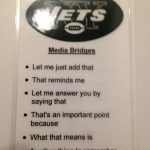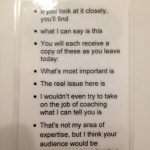Do you know how to pivot, or bridge a difficult or unflattering question from a reporter into an answer that puts your agency in a more positive light?
The NFL’s New York Jets recently gave their players a laminated card which phrases they could use to spin their answers. New York Daily News reporter Manish Mehta took photos of one of the cards and tweeted it out.
Granted, it’s the Jets. So they have been mocked mercilessly and it is embarrassing to the organization that the card has been seen by reporters and the public. But that doesn’t mean the idea of helping players bridge tough questions into positive answers is wrong.
Here are some of the “bridge” suggestions of how to transition from a difficult question to a more positive message:
- Let me just add that…
- That reminds me…
- Let me answer you by saying…
- Another thing to remember is…
- If you look at it closely you’ll find…
- The real issue here is…
- That’s not my area of expertise, but I think your audience would be interested to know that…
Putting a positive spin on an embarrassing or negative story is part of the job as a spokesman, but it doesn’t stop there. The reality is that every employee is a spokesman or public ambassador of the company. The key is knowing what you want to say BEFORE the reporter even asks the question.
Let’s say that a company vehicle with your logo gets in a bad crash and media start asking questions. An immediate response might be: We’re investigating the cause of today’s crash involving one of our vehicles, but it’s important to note that our company has 50 vehicles on the road travelling more than 700,000 miles a year. All drivers have passed a background and driving record checks, and have completed company driver training before receiving driving status to operate our vehicles. Once the investigation is complete, we’ll review the findings to ensure we’re doing everything possible to protect and care for our patients and the public.
In this simple deflection I provided lots of new facts and figures that could be included in a story. If all I did was say the company was investigating, or acknowledge that the company driver caused the crash, the only thing the reporter can say is negative because they have nothing else to consider reporting or sharing within their story.
Sharing a silver lining in a negative story is completely appropriate, but let me be clear. A spokesman should NEVER lie to a reporter. Lie once and get caught, and you’ll never be trusted again. There’s an adage that “crow taste better warm than cold.” If your company or an individual employees makes a mistake, acknowledge it.
Think of it this way. Fire fighters run into the fire, not away from it. Your strategy should be the same for negative stories. Put out the kitchen fire before it becomes a house fire. I used to joke that when I served as the spokesman for an ambulance company, I hadn’t realized I was signing up to be a fire fighter because I’d spend most of my day putting out fires. The faster you acknowledge and respond to a story that may be negative the better. In acknowledging the mistake, explain what changes you’re making to help make sure similar mistakes don’t occur again in the future.
Pivoting to a positive response increases the options for the reporter to write a positive, or at least less negative, story. More company spokespeople should memorize and carry a card like the Jets.
Looking for practical ways to practice? Have a friend or co-worker start by giving you an obscure company fact or even a completely unrelated physical item—like aluminum siding. Then, have the person ask you a question. The question doesn’t even need to be serious. It can even by “why did the chicken cross the road.” Your task is to logically, and conversationally transition the question of why the chicken crossed the road to an answer about aluminum siding.
Initially, it’s going to be difficult to make the transition feel natural and less obvious. But after a little practice after you get comfortable using a bridge statement, it’ll become easy. You just need to have the right players in position, practice and execute the game plan. Just like the Jets.
p.s.: For the record, no I’m not Jets fan. Go Cleveland Browns (hometown)! Go Arizona Cardinals (home for the last 13 years)!

